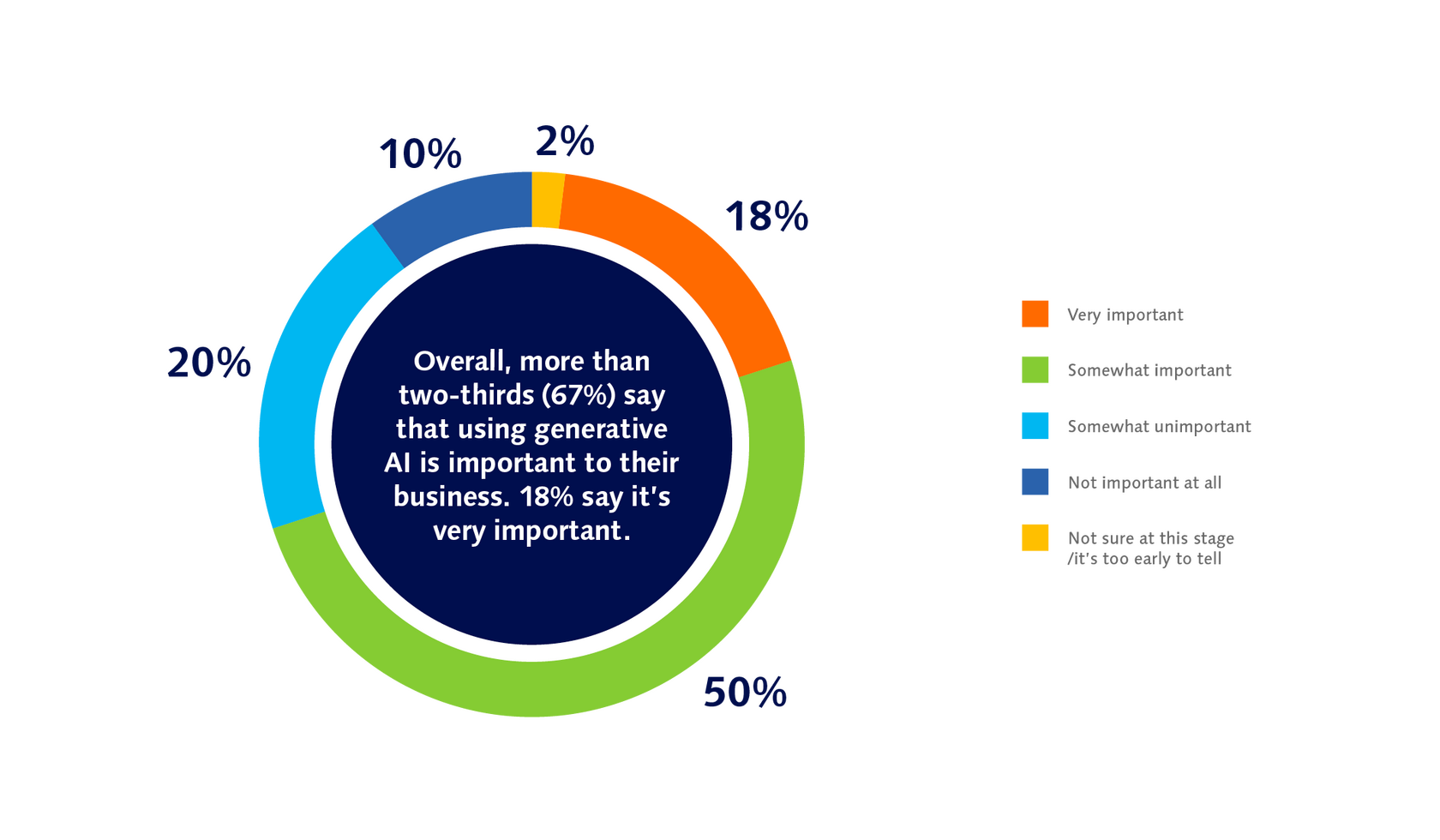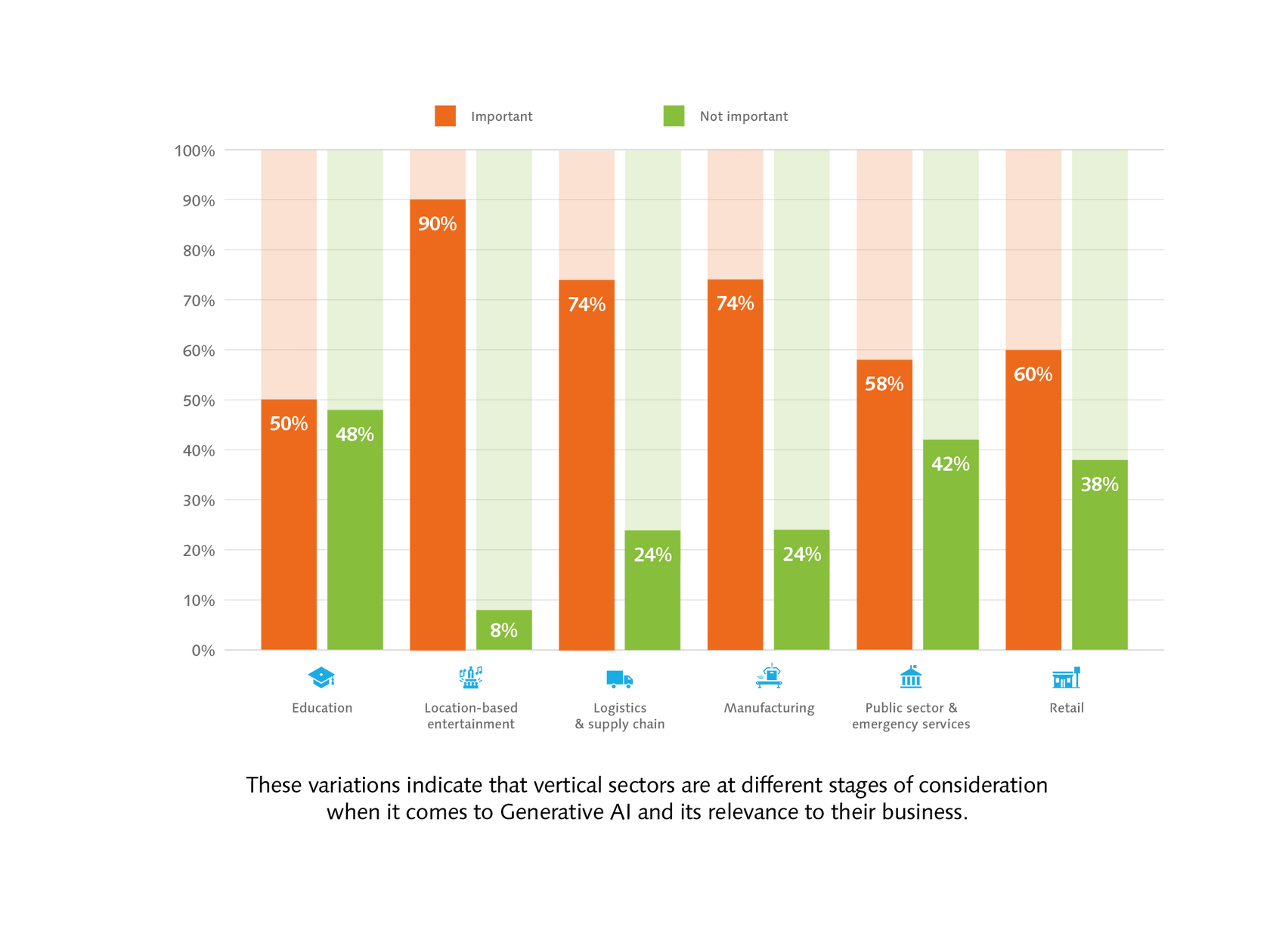Visions of the Future: How Computer Vision Technology is Transforming Industries
Breadcrumb
Visions of the Future: How Computer Vision Technology is Transforming Industries
"As Computer Vision technology verges on the edge of widespread implementation, we undertook this research to learn more about the use cases, expectations, and barriers – both practical and ethical – around its adoption. As we look forward to a future where AI solutions complement and interact with each other, we also explored how the same respondents see generative AI technologies influencing their organisation."

Head of AI
Panasonic Connect Europe
At a glance findings
Productivity expectations are high.
On average, respondents anticipate a productivity increase of 42%, rising to 52% in manufacturing and dropping to 32% in location-based entertainment.
These variations are likely related to its use cases in each sector – while manufacturing applications are likely to increase the quantity of output organisations can deliver, in locationbased entertainment the focus is much more on the quality of user experiences; providing better experiences rather than more of them.
Computer Vision technology is used across a wide variety of business departments and applications.
Practical activities such as repairs and maintenance, production line monitoring, and Practical activities such as repairs and maintenance, production line monitoring, and quality control slightly outweigh use in security and health and safety. control slightly outweigh use in security and health and safety.
Applications in logistics and supply chain are popular, along with real-time projection mapping and people tracking, demonstrating the broad scope of use cases relevant to Computer Vision technology.
Practical barriers relate to support, knowledge, and implementation costs.
Installing new technologies is only the first step. Organisations report that they are struggling to find third-party support.
High demand for skills in new technology areas often results in battles for talent, with companies struggling to retain knowledge within the business as employees are tempted by high salaries elsewhere. High costs are always a consideration, too, especially for early adopters, and our research bears this out.
Ethical concerns show organisations are aware of AI’s moral maze.
Data security, privacy, a lack of corporate guidance, and fears of job displacement are all key concerns for professionals already deploying AI. They show awareness of the ethical issues relating to different AI use cases, demonstrating that these form part of decision-making around implementation.
As companies attempt to find a balance between the business advantages of AI and its impact on their workforce and wider society, this awareness should evolve into practical strategies to support effective but sensitive AI deployments.
AI professionals are enthusiastic about GenAI and adoption is rapid.
68% of respondents say generative AI is important to their organisation and more than a third have already implemented solutions and are seeing benefits.
Experts who have already overseen the implementation of computer vision in their organisation should be in a strong position to introduce generative AI and identify where AIs can co-operate to enhance and automate processes.
Methodology:
The research was conducted by independent research company, Opinion Matters, among 300 senior decision makers responsible for digital transformation and AI/ computer vision implementation working in companies with an annual turnover of 50 million+ Euros across Germany and the UK.
"Our research participants told us they are utilising Computer Vision across a huge range of vertical sectors, business functions, and use cases. There are some definite hot spots – manufacturing organisations, for example, predict the highest productivity increases, and several of the most popular use cases link closely to the increasing automation of manufacturing. Retail organisations also show higher adoption of AI use cases across the board, compared to other sectors. Every new technology meets barriers to implementation, but the transformative nature of AI means that these are not limited to practical concerns, such as a lack of technical skills or budget; they also include ethical issues that are important from a social and cultural perspective. Our study reveals that respondents are well aware of the challenges around AI implementation and understand the potential specific issues relating to the use cases they are implementing. This is a positive sign for future adoption; it points to organisations managing and overcoming some of the objections that commonly arise when adopting revolutionary technologies such as these."

Head of AI
Panasonic Connect Europe
In which business operations, if any, does your organisation mainly utilise computer vision technology?

Strong adoption across industry sectors
Manufacturing companies, retail businesses, and those in the logistics and supply chain sector show greater adoption of computer vision for quality control testing or inspection. The research shows that retail companies are more likely to be using Computer Vision in security operations. In fact, retail respondents show higher adoption of Computer Vision across most business operations. A Computer Vision solution installed in the retail environment can accomplish a multitude of tasks. In which business operations, if any, does your organisation mainly utilise computer vision technology?
Security is just one aspect, but tracking people through stores can identify buying behavior, analyse customer flow, and reveal age and gender composition. This is borne out when we examine the types of Computer Vision applications in use by retail – respondents in this sector are more likely to be using people-tracking and facial recognition software than those from other sectors.
"Although the main focus of computer vision in Retail is still security and loss prevention, by identifying patterns and suspicious behaviour, we are seeing a trend to using the technology to improve the efficiency of goods replacement on the shelves in the store. Using computer vision for product recognition enables retailers to compare planograms (plan on the shelf) with realograms (reality on the shelf). It can inform them, for example, if a product is in the wrong place or if there is not enough stock, so replenishment can be prioritised."

Head of R&D Europe
Panasonic Connect Europe
Which Computer Vision applications are mainly used in these operations?
Tracking to measurement
"Visual Sort Assistant uses object recognition and map projection technology to facilitate the sorting of parcels according to their destination. It reduces the assessment time for sorting parcels by eliminating the need to train workers to read label information on parcels - improving the efficiency and accuracy of the sorting operation."

Head of R&D Europe
Panasonic Connect Europe
Versatility of Computer Vision
Computer Vision technology is used across a wide variety of applications, demonstrating its exceptional versatility. The most common application is volume measurement, including pallet volume for efficient loading and transportation. Here, Computer Vision can instantly assess the orientation and available space in pallets, or other containers such as roller cages, and calculate the available capacity before loading. This ensures the optimum use of available space and improves efficiency.
Real-time projection mapping, the second-most commonly cited application, has a number of has a number of applications in both Location Based Entertainment and Logistics.
In entertainment, it can be used to create incredibly dynamic special effects and immersive experiences for performers, audiences, and game players by enabling seamless tracking of physical objects within projected environments. Think logos or special effects projected in real-time onto fast moving objects or performers creating special effects live on stage as they move.
In Logistics, the technology can also be applied to assist in the automated tracking and sorting of objects in warehouse environments, for example.
"Real-time projection mapping in the entertainment industry has been used for everything from enhancing stunning performances at the opening of the Olympics, right through to creating immersive entertainment and interactive games. The integration of AI-driven computer vision into this technology will take visual projection capabilities to another level. At the projector level, AI applications can be integrated using the Intel® SDM slot. AI capabilities will also enhance predictive capabilities in remote maintenance services."

Location Based Entertainment
Panasonic Connect Europe
Image retrieval use cases are widespread
Content-based image retrieval, third on the list, also has many applications across a range of verticals. In healthcare, for example, it can be used to assist diagnosis by allowing comparisons between diagnostic images and similar archived pictures of patients where outcomes are known. In law enforcement, it can be used to identify persons of interest appearing in different locations or for analysing and retrieving Automatic Number Plate Recognition (ANPR) information.
Many of these applications can work in tandem, such as people tracking solutions in conjunction with content-based image retrieval for security purposes. Others will interact at different stages to undertake a process, such as out-of-stock detection in retail linking to automated ordering solutions that trigger Computer Vision transport and logistics solutions.
"In law enforcement, the automatic detection and reading of vehicle number plates can be used to instantly access information on over 30 national and international databases. This vital information can be displayed in vehicle via a TOUGHBOOK tablet to provide police officers with critical insights about the vehicle and owner/driver prior to approaching the vehicle. This has important safety and intelligence advantages."

Rugged Device specialist
Panasonic Connect Europe
How much, if at all, do you see Computer Vision technologies increasing productivity in your company in the next three years?
Delivering productivity promises
Computer Vision technology is relatively mature compared to many other AI solutions. As a result, it is on the verge of delivering on its productivity promises. The timing is perfect for businesses and governments – the UK and Germany included – that have been grappling with how to increase sluggish productivity levels since the 2008 financial crisis.
Our study corroborates wider evidence that organisations see AI as the route to higher productivity. On average respondents expect to see a productivity increase of 42% in the next three years from implementing Computer Vision technology.
It seems that productivity is a bigger driver for business leaders than replacing the human workforce. This fear is often cited as a barrier to AI adoption, but studies by Microsoft2 have indicated that leaders are almost twice as likely to value AI’s ability to increase employee productivity than they are its potential to reduce headcount.

"AI is already in use in some of our manufacturing solutions, such as solder paste printer and SMT Component Mounting Machines (SMT Mounter). Rapid improvements in computer vision is likely to assist in two additional areas: 1. Electronics Final assembly When products leave the automated production line, often additional components need to be inserted or sub-assemblies connected to main boards. This fiddly task is performed by people. The latest computer vision with increased accuracy and sensitivity mayovercome these challenges. 2. Analyzing and optimising operator movements Computer vision, backed by AI, will enable manufacturers to automatically analyse and optimise the movements of operators inside a factory and in manufacturing cells to rapidly improve efficiency."

SMT specialist
Connect Europe
"Our latest welding robot control system has the capability to integrate emerging AI-driven computer vision applications. In the future these innovations could be used to improve the efficiency and quality of welding."

Robot and Welding expert
Panasonic Connect Europe
Expectations vary by sector
Location-based entertainment respondents have lower productivity expectations, although they still anticipate a healthy 32% increase. This may be explained by the role of Computer Vision in this sector. Rather than increasing the quantity of what is produced, Computer Vision technology is all about raising the quality of entertainment experiences.
By using solutions such as real-time projection mapping, companies can deliver fully immersive, seamlessly interactive, merged virtual-physical experiences that offer a genuine “wow” factor and take entertainment to the next level. This adds huge value for customers and raises their expectations of live entertainment, helping companies compete in a crowded market.
In the Education sector, Computer Vision technology is already being used for auto-tracking teachers as part of the camera systems recording and streaming for lecture capture solutions. This technology is equally adept in use at corporate meetings and conferences, as well as entertainment video production
"AI-driven applications are taking the strain out of video production in a number of ways. Our Built-in Auto-Tracking with AI enables single and multi-camera shoots to be filmed more easily. The automation and the tracking reduces the burden on AV staff or operators, allowing them to focus on content creation and maintaining high-quality, professional content output. In our Media Production Suite, AI is used in the Video Mixer Plugin for Chromakeyless output. The AI Keying function eliminates the need for a green background, even when shooting outdoors – providing automation, easy-set-up and high-quality output."

Product Marketing Manager Broadcast & ProAV
Panasonic Connect Europe
Whitepaper - Visions of the Future - What main technological and business barriers
Barriers still remain
Any new technology encounters barriers on the way to delivering benefits. The speed at which AI technologies are now developing has foreseeable effects when it comes to real-world implementation. Accordingly, while our study shows a groundswell of support for Computer Vision technology, respondents note barriers around costs and skills deficits.
These two most common issues are related; there is always a delay between the introduction of a new technology and the development of sufficient people with the engineering skills needed to use and maintain it. In both customer organisations and third-party support providers, employees with experience in Computer Vision technology quickly find themselves in demand, and the salaries they can command rise accordingly. This makes it hard to retain talent and creates a deficit of internal expertise and external support.
Costs are a common challenge in any new implementation. Decisions such as whether to use cloud or edge-based image processing rely on a variety of application-specific factors, but they can have a considerable impact on the total cost of ownership depending on the complexity and volume of frames involved.
Ultimately, organisations need to ensure that they have built a comprehensive business case around the productivity benefits of Computer Vision and the associated costs.
What are the main ethical barriers, if any, to deploying Computer Vision in your business?
Data security is the biggest concern
AI applications have incredible transformative potential but alongside major change often comes major adjustment for society. Organisations have a duty to manage this impact, meaning ethical considerations should be part of deployment decisions. AI also introduces privacy and security concerns to add to those already inherent in a world where much of our personal information is digitised. As a result, regulation is another important consideration for organisations adopting Computer Vision technology.
Our research finds that data security is the most common concern. This is likely the result of both the dangerous cyber threat environment, where bad actors seek to steal valuable data for profit or ideological reasons, and the evolving regulatory landscape, where the punishment for data security breaches is severe.
Privacy and surveillance are also issues
Personal privacy and surveillance concerns are closely related to data security and are the second-most common ethical concern. Any personal information collected must be protected from both an ethical and regulatory perspective. There is also the wider moral issue associated with applications such as facial recognition and people-tracking; a balance must be struck between the importance of the application and basic human rights to privacy.
Fears that AI will replace human jobs are commonly raised as a leading concern. Our respondents are all professionals working in the field of Computer Vision and digital transformation, so may be less concerned about the effect on them personally, but they clearly recognise that job displacement is an important consideration.
Key ethical concerns relate to the applications in use
There were some interesting insights when we analysed the concerns of highest importance to respondents using different Computer Vision applications. Overall, it seems that respondents have a good understanding of the ethical concerns relating to each use case. Those using Computer Vision applications for people tracking were most concerned about the lack of corporate guidance for its use (53% - far higher than the 32% average), followed by its personal privacy and surveillance concerns (40%). Unsurprisingly, those using it for facial recognition were most concerned about personal privacy and surveillance concerns (46%).
For respondents using Computer Vision for image or document classification, data security is the top concern (45%), which again aligns with the use case, as documents will be digitally stored and retrieved once they have been classified, so they must be protected.
Interestingly, respondents using Computer Vision for health and safety purposes are considerably less worried about personal surveillance and privacy concerns than the general cohort. Only 15% of respondents in this sector see this as a problem, compared to the 32% average. This may be because they believe health and safety considerations outweigh privacy in the applications where it is used, such as monitoring care environments for the elderly, for example.
In contrast, respondents using Computer Vision for repairs and maintenance are far more concerned about personal privacy and surveillance concerns than the average (44%). This may
be due to the human task aspect of the use case, with engineers unwilling to be monitored so closely when carrying out their work.
"In advancing computer vision technologies, we must embed ethical considerations at the core, ensuring that every application respects privacy, promotes equity, and serves the greater good without exception."

Head of AI
Panasonic Connect Europe
AI introduction must be sensitive to ethical concerns
There are undoubtedly a variety of ethical barriers to overcome during the rollout of Computer Vision – and other – AI applications. As with any transformative change, there are phases of response ranging from shock and denial through anger and acceptance, before a willingness to try the new approach. The fact that our respondents are aware of the issues likely to affect AI implementation is a positive first step in managing this process.

At what stage are you in the implementation of more general Generative AI technologies, such as ChatGPT, in your business, if you use it at all?
A green light for AI
Looking at the wider adoption of Generative AI, the momentum is clear. More than one-third of respondents (37%) have already implemented a solution and are seeing benefits; 18% are starting to see medium- to long-term benefits. A further third (34%) are in the planning stage or the process of implementing the technology. 17% are still thinking about it, but only 13% say they will not deploy Generative AI at all.
Computer Vision has already walked the path that generative AI will need to take before it becomes a genuine benefit to productivity. Professionals who have helped to implement Computer Vision in their organisations should find they can transfer their expertise to generative AI to accelerate its adoption.
How important, if at all, is the use of Generative AI technologies in your overall business transformation journey?


Our study shows the growing importance and continued potential of Computer Vision technology, a field that stands at the forefront of AI’s practical application across industries. This technology, often regarded as the ‘eyes of AI’, is not just a concept of the future but a present reality, that can steer businesses towards significant productivity and operational enhancements.
With an anticipated average productivity increase of 42% over the next three years—reaching as high as 52% in manufacturing sectors—Computer Vision is setting the stage for a revolution in how businesses operate. Its applications, ranging from quality control and logistics to user experience enhancement, signal its versatility. In addition, the wide adoption rates and the enthusiastic reception of GenAI can only accelerate innovation in this area.
While acknowledging the challenges—both practical, like skill gaps and implementation costs, and ethical, like data security and job displacement—our study also underscores the proactive stance of businesses in navigating these complexities. The keen awareness and thoughtful approach to these issues are indicative of a mature, responsible journey towards AI integration.
The trajectory is clear: Computer Vision, in concert with other AI technologies, is not just shaping the future of business— it’s defining it. We invite you to contact us to exploring further how we can help you to harness the potential of AI to redefine your business.
"We hope you find this study informative and insightful. If you’d like to learn more about how Panasonic is developing ground-breaking Computer Vision solutions for applications from entertainment and manufacturing to logistics and supply chain management, please get in touch."

Head of AI
Panasonic Connect Europe
Read more insights…
blog
Connecting Our Customers to Tomorrow: A New Era for Panasonic Connect Europe
In today’s dynamic business landscape, transformation is no longer a choice. It’s a necessity.
blog
Navigating Change: How Technology Can Power European Business Transformation
European organisations face a challenging 2025 with an uncertain socio-economic backdrop but there are also incredible opportunities being delivered by the latest technologies, explains Shusuke Aoki, new CEO & Managing Director at Panasonic Connect Europe. Now is the time to be bold and grasp that technological opportunity.
whitepaper
Integrating Generative AI into Sales
Until the public release of ChatGPT in November 2022, the debate about the impact of generative AI on work was largely academic. In the short time since its launch, the discussion has become very real. Generative AI is changing the way people work – and fast.
blog
The Future of B2B Marketing Requires a New Marketer
The last industrial revolution changed the way we work forever. The next one is happening right now. But this time, it’s not about steam engines or assembly lines. It’s about artificial intelligence (AI) and its power to reshape B2B marketing as we know it.
Sorry there was an error...
The files you selected could not be downloaded as they do not exist.
You selected items.
Continue to select additional items or download selected items together as a zip file.
You selected 1 item.
Continue to select additional items or download the selected item directly.
Share page
Share this link via:
Twitter
LinkedIn
Xing
Facebook
Or copy link: